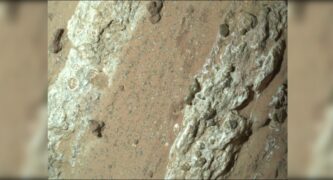“These spots are a big surprise,” said David Flannery, an astrobiologist and member of the Perseverance science team from the Queensland University of Technology in Australia. “On Earth, these types of features in rocks are often associated with the fossilized record of microbes living in the subsurface.”
Spotting of this type on sedimentary terrestrial rocks can occur when chemical reactions involving hematite turn the rock from red to white. Those reactions can also release iron and phosphate, possibly causing the black halos to form. Reactions of this type can be an energy source for microbes, explaining the association between such features and microbes in a terrestrial setting.
In one scenario the Perseverance science team is considering, Cheyava Falls was initially deposited as mud with organic compounds mixed in that eventually cemented into rock. Later, a second episode of fluid flow penetrated fissures in the rock, enabling mineral deposits that created the large white calcium sulfate veins seen today and resulting in the spots.
Another Puzzle Piece
While both the organic matter and the leopard spots are of great interest, they aren’t the only aspects of the Cheyava Falls rock confounding the science team. They were surprised to find that these veins are filled with millimeter-size crystals of olivine, a mineral that forms from magma. The olivine might be related to rocks that were formed farther up the rim of the river valley and that may have been produced by crystallization of magma.
If so, the team has another question to answer: Could the olivine and sulfate have been introduced to the rock at uninhabitably high temperatures, creating an abiotic chemical reaction that resulted in the leopard spots?
“We have zapped that rock with lasers and X-rays and imaged it literally day and night from just about every angle imaginable,” said Farley. “Scientifically, Perseverance has nothing more to give. To fully understand what really happened in that Martian river valley at Jezero Crater billions of years ago, we’d want to bring the Cheyava Falls sample back to Earth, so it can be studied with the powerful instruments available in laboratories.”
More Mission Information
A key objective of Perseverance’s mission on Mars is astrobiology, including caching samples that may contain signs of ancient microbial life. The rover will characterize the planet’s geology and past climate, to help pave the way for human exploration of the Red Planet and as the first mission to collect and cache Martian rock and regolith.
NASA’s Mars Sample Return Program, in cooperation with ESA (European Space Agency), is designed to send spacecraft to Mars to collect these sealed samples from the surface and return them to Earth for in-depth analysis.
The Mars 2020 Perseverance mission is part of NASA’s Moon to Mars exploration approach, which includes Artemis missions to the Moon that will help prepare for human exploration of the Red Planet.
NASA’s Jet Propulsion Laboratory, which is managed for the agency by Caltech, built and manages operations of the Perseverance rover.
For more about Perseverance:
science.nasa.gov/mission/mars-2020-perseverance















 4 comments
4 comments


